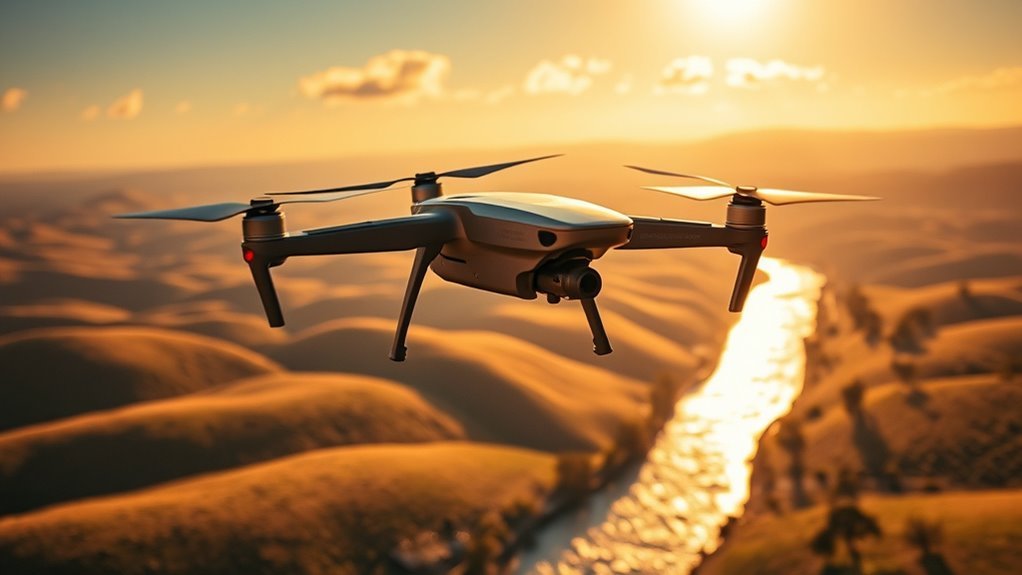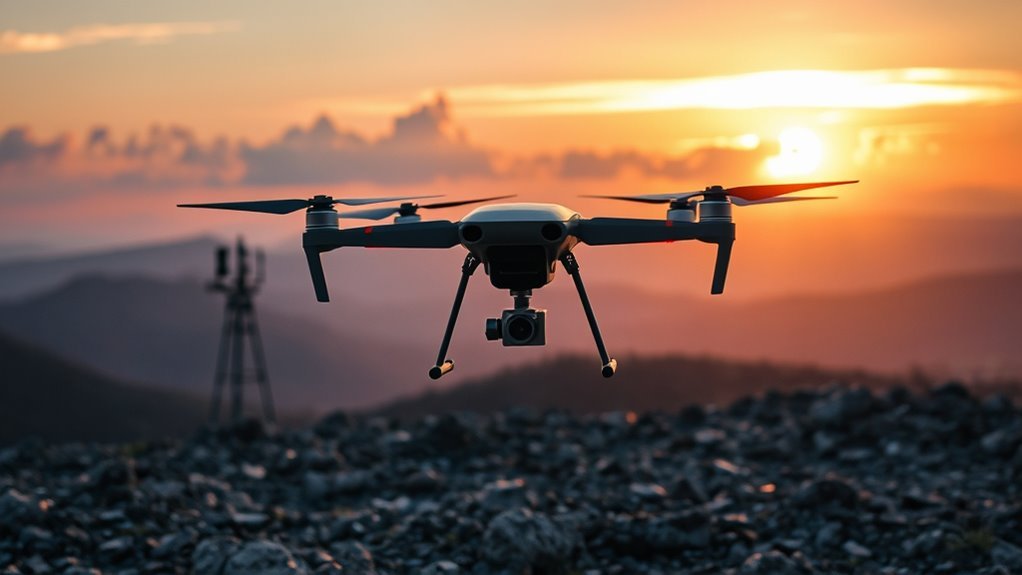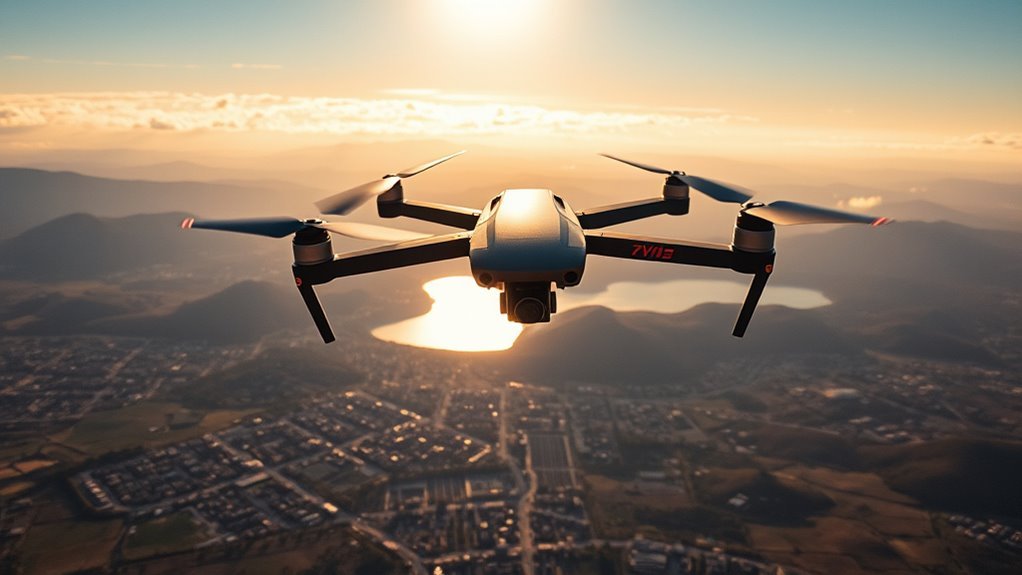Several factors affect how far your drone can go. Battery life is vital, as capacity directly impacts flight duration. The weight and payload must be carefully managed to optimize performance. Adverse weather conditions, like wind and precipitation, can hinder flight efficiency. Signal range and technology influence communication reliability, while your chosen flight mode can impact energy consumption. Regular maintenance and your skill level as a pilot also play significant roles. You might find more insights essential for maximizing your drone’s range.
Battery Life

While you may not realize it, battery life is one of the most vital factors influencing a drone’s range. The type of battery chemistry utilized directly impacts energy density and overall performance. Lithium-polymer (LiPo) batteries, for instance, offer high discharge rates and light weight, making them ideal for drones. However, efficient power management is essential for maximizing flight time. This involves optimizing the drone’s systems to minimize energy consumption, ensuring that every watt is utilized effectively. By implementing advanced power management strategies, you can considerably extend your drone’s operational range. Understanding the interplay between battery chemistry and power management is important for achieving the freedom to explore vast distances without the worry of an early return due to a depleted battery. Additionally, battery capacity plays a crucial role in determining how long a drone can stay airborne. Furthermore, battery types significantly influence flight duration, as different chemistries provide varying advantages.
Weight and Payload

Battery life isn’t the only factor that determines how far a drone can travel; weight and payload play a considerable role as well. A drone’s design greatly impacts its payload capacity, which directly influences range. When you overload your drone, it consumes more power to maintain altitude and stability, reducing distance.
Consider these factors:
- Total Weight: A heavier drone requires more energy to operate, shortening its range. This is particularly evident as signal attenuation increases with additional weight, further limiting effective range.
- Payload Capacity: Exceeding this limit hampers performance, affecting flight duration.
- Aerodynamics: Poor design can increase drag, further diminishing efficiency. Additionally, payload optimization strategies are essential to enhance overall efficiency and ensure safe operations.
Weather Conditions

Although many pilots focus on battery life and weight, weather conditions greatly influence a drone’s operational range. Wind resistance can greatly affect a drone’s flight efficiency; strong winds require more power, thereby reducing distance. If you’re flying in gusty conditions, your battery may deplete faster than anticipated. Precipitation effects also come into play; rain or snow can add weight and create drag, making it harder for your drone to maintain altitude and speed. This not only impacts the drone’s range but can also lead to malfunctions if not properly equipped for such conditions. Understanding these factors allows you to plan your flights better, ensuring you maximize your drone’s capabilities while maneuvering unpredictable weather. Additionally, aerodynamic design and shape play a crucial role in how well a drone can cope with adverse conditions. For instance, drones like the Autel EVO Lite+ V2 can enhance safety and efficiency in challenging environments such as rain and dusk, thereby improving flight stability.
Signal Range and Technology
Weather conditions can greatly impact a drone’s performance, but the technology powering its signal range plays an equally important role in determining how far you can fly. Key factors include:
- Signal Interference: Obstacles like buildings or trees can disrupt the signal, limiting your operational range.
- Communication Protocols: Drones utilize various protocols, such as Wi-Fi or radio frequencies, which greatly affect transmission distance and reliability.
- Antenna Design: The quality and type of antenna can enhance signal strength, allowing for longer distances. Additionally, advanced collision avoidance systems can help maintain operational range by preventing accidents that could cut flights short.
Additionally, environmental conditions such as radar signal propagation can affect the overall effectiveness of your drone’s range. Understanding these elements is essential for maximizing your drone’s potential. By choosing the right technology and being aware of potential interference, you can push your drone’s range further, releasing greater freedom in your aerial adventures.
Flight Mode and Speed
When operating a drone, the selected flight mode greatly influences its range and efficiency. Different modes, such as manual or autonomous, can alter energy consumption rates, while speed adjustments directly impact battery life and signal stability. Understanding these dynamics is vital for optimizing performance during flight. Additionally, firmware impact on range can significantly affect how effectively a drone utilizes its power management systems. Proper power management is essential for maximizing the distance a drone can travel before needing a recharge.
Flight Mode Variations
As you consider the factors influencing drone range, it’s important to recognize how flight modes and speed play a crucial role. Different flight modes can greatly impact the drone’s efficiency and distance traveled.
- Autonomous navigation allows for optimized flight paths, reducing energy consumption.
- Manual control often results in variable speeds and unpredictable maneuvers, affecting overall range.
- Certain modes prioritize speed, which can lead to quicker battery depletion.
Understanding these variations helps you make informed decisions about your drone’s operational capabilities. By selecting the appropriate flight mode based on your mission requirements, you can enhance your drone’s performance and maximize its range, ensuring a more liberated flying experience.
Speed Impact Analysis
While speed is a critical factor in determining a drone’s range, its impact varies considerably based on the selected flight mode. Understanding this relationship is essential for effective speed optimization and maximizing your drone’s potential. Each flight mode interacts differently with drone aerodynamics, influencing how altitude and wind resistance affect speed.
| Flight Mode | Speed (mph) | Range (miles) |
|---|---|---|
| Sport | 30 | 10 |
| Standard | 20 | 15 |
| Economy | 15 | 20 |
In sport mode, your drone may achieve higher speeds, but the range decreases due to increased energy consumption. Conversely, economy mode enhances range at the cost of speed, demonstrating the intricate balance between speed and operational efficiency.
Maintenance and Upkeep
Proper maintenance and upkeep are essential for maximizing a drone’s range and overall performance. By focusing on preventive maintenance and conducting routine inspections, you can guarantee your drone operates at peak efficiency. Here are key aspects to reflect on:
- Battery Care: Regularly check battery health and charge cycles to optimize power usage.
- Propeller Inspection: Examine propellers for any signs of wear or damage that could impact flight stability.
- Firmware Updates: Keep your drone’s software updated to improve performance and fix known issues. Additionally, regular inspections help identify parts needing attention or replacement, ultimately extending your drone’s operational lifespan.
Pilot Skill and Experience
Your understanding of regulations and flight techniques greatly influences the effective range of your drone. Knowledge of airspace rules guarantees compliance and minimizes the risk of interference, while proficiency in flight techniques optimizes battery usage and control. Both factors directly affect how far and efficiently your drone can operate in various conditions. Additionally, being aware of local regulations ensures that you can fly your drone legally and safely over various areas. A skilled pilot can also leverage efficient power management to enhance flight endurance and extend the operational range.
Knowledge of Regulations
Understanding the complex regulations governing drone operation is essential for maximizing range and guaranteeing safe flights. Your knowledge of drone regulations not only fosters legal compliance but also enhances your operational capabilities. Familiarizing yourself with these rules can greatly impact your drone’s performance and longevity.
- Airspace Restrictions: Knowing where you can and can’t fly helps avoid penalties and guarantees safe navigation.
- Altitude Limits: Adhering to altitude regulations prevents interference with manned aircraft and increases your flight range.
- Registration and Licensing: Guaranteeing that your drone is registered and you’re licensed can expand your operational opportunities.
Flight Technique Proficiency
Following compliance with regulations, pilot skill and experience greatly influence drone range and performance. Your ability to master flight maneuvering techniques directly impacts how far your drone can travel efficiently. Advanced piloting strategies, like optimizing altitude and speed, can extend flight time while conserving battery life. For instance, smooth shifts and controlled turns minimize energy loss, allowing for greater distances. Additionally, understanding wind patterns and environmental factors enables you to adjust your flight path accordingly, enhancing overall range. As you gain experience, you’ll intuitively apply these techniques, maximizing your drone’s capabilities. As a result, honing your skills isn’t just an option; it’s essential for achieving the freedom of flight you desire, ultimately pushing the boundaries of your drone’s performance.
Frequently Asked Questions
How Do Drone Regulations Impact Flight Distance?
Drone laws greatly impact your flight distance, as they dictate permissible flight zones. Restrictions on altitude and geographic areas can limit your operational range, potentially hindering your ability to explore and utilize drones to their fullest.
Do Terrain Types Influence Drone Range?
Did you know that drones can lose up to 30% range on rugged terrain? Terrain challenges and surface friction greatly impact battery performance, making it essential for you to take into account the environment when planning your flight.
Can Drone Accessories Affect Flying Distance?
Yes, drone accessories can considerably impact flying distance. Upgrading battery capacity enhances flight time, while optimizing antenna design improves signal range. These modifications enable you to extend your drone’s operational limits and explore further with confidence.
How Does Drone Model Affect Maximum Distance?
When considering a drone model, you’ll find battery capacity influences flight time, while weight distribution affects stability. A well-designed drone balances these aspects, allowing for both extended range and enhanced maneuverability during your aerial adventures.
Are There Altitude Limits for Drone Flights?
Yes, there’re altitude restrictions for drone flights. You’ll need to adhere to legal guidelines, which typically limit flight heights to 400 feet. Understanding these regulations guarantees you maintain both safety and compliance while enjoying your drone’s capabilities.

